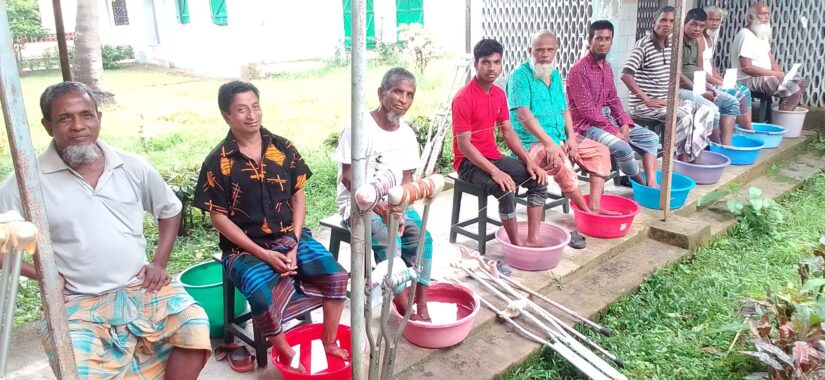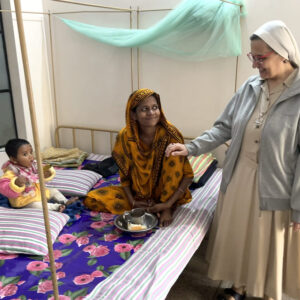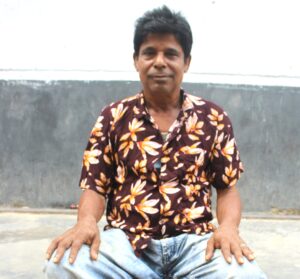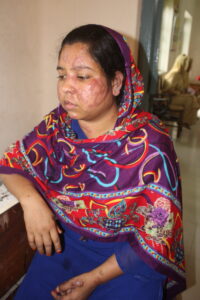
Caritas Bangladesh fights against Leprosy
Md. Ayub Ali, a 65-year-old resident of Balubari Dhipipara village, Dinajpur, lived with undiagnosed leprosy for years. He leads a modest life with his wife and son, operating a small restaurant in the local market. The family’s income depends solely on this small business, as Ayub owns no land other than his homestead.
For a long time, Ayub had pale spots on his hands and feet. The spots were painless and not itchy, so he ignored them, even though his wife urged him to seek medical attention. However, his condition came to light on January 9, 2023, when staff from the DLC visited his home as part of their community outreach program.
The DLC staff informed Ayub’s family about leprosy, its symptoms, and the availability of free treatment. Ayub showed the workers the pale spots on his body. Recognizing that the spots lacked sensation—a common sign of leprosy—the staff encouraged him to visit the Dinajpur Sadar Clinic for a formal diagnosis.
Following their advice, Ayub visited the clinic that same day. There, the doctor conducted tests and confirmed that Ayub had multibacillary (MB) leprosy. The doctor explained the risks of untreated leprosy, such as limb deformities, and emphasized the importance of regular medication for recovery. Although initially frightened, Ayub felt reassured by the doctor’s explanation that consistent treatment could control the disease.
Ayub was prescribed free medication and started his treatment immediately. The doctor’s words helped alleviate his fear, and he began following the prescribed regimen. Since starting treatment, Ayub has seen gradual improvement. The pale spots on his hands and feet are slowly fading, and he continues to take his medication regularly. The treatment has given him renewed hope for his future.
“Without the intervention of the Dhanjuri Leprosy Center staff,” Ayub said, “I may not have sought medical attention until the disease progressed further, potentially leading to severe complications. The DLC of Caritas Bangladesh has been a beacon of hope in my life, I am thankful to DLC for their generous support”
Najma Begum, 28, a housewife from Baltair village under Sadar Upazila, Dinajpur, has faced the challenges of leprosy while managing a modest household. Her husband, Rubel Talukdar, works as a daily laborer. For two to three years, Najma experienced paralysis and weakness in her left thumb but paid little attention to it. Gradually, red spots appeared on her hands, feet, forehead, and cheeks. The spots grew slowly but caused no itching or burning sensation. Najma continued to ignore these symptoms until she met staff from the Dhanjuri Leprosy Center (DLC) during a community awareness program.
The DLC staff educated Najma about leprosy symptoms, prompting her to show them the red spots on her body. Recognizing the signs of leprosy, they encouraged her to visit the leprosy clinic for further examination. Najma visited the DLC.
She described her symptoms to the doctor at DLC, who performed a thorough examination and recommended a skin test. The results confirmed the presence of leprosy bacteria, and Najma was diagnosed with multibacillary (MB) leprosy. The doctor prescribed Multi-Drug Therapy for MB leprosy (MDT-MB) for 12 months, and Najma began her treatment immediately.
Since starting treatment, Najma has been taking her medicine regularly. Gradually, the red spots on her body have started to fade, and her condition has improved significantly.
Najma reflects, “I have found hope through the free treatment provided by the DLC and my life is becoming better.”
Like Ayub Ali and Najma Begum, hundreds of leprosy patients have received treatment in the past year from Caritas Bangladesh’s hospitals, such as the Dhanjuri Leprosy Center and the Khulna Leprosy & TB Control Hospital. Their efforts continue to bring hope and healing to those affected by leprosy.
Today marks World Leprosy Day, observed every year on the last Sunday of January since 1953 to raise awareness about leprosy. This day was introduced by French humanist Raoul Folliero, one of the founders of the International Federation of Anti-Leprosy Associations (ILEP). Folliero chose the date as the third Sunday after Epiphany in the Catholic calendar—the day when Jesus Christ healed a leper.

Dr. Sr. Roberta Pignone, Project & Medical Director, Khulna Leprosy and Tuberculosis Control Project with a patient
Agapit Tudu, Acting Director of DLC, told Caritas Bangladesh Communications that significant efforts are still needed to support leprosy patients. “They face immense challenges,” Tudu explained. “When we hold community outreach program in remote villages, we see many patients.”
Leprosy is an ancient disease, mentioned in the religious scriptures of Islam, Hinduism, and Christianity. Even in modern times, people continue to fight this disease. At one point, it was believed that those who contracted leprosy were cursed by God, and this superstition still persists.
Tudu also mentioned that people affected by leprosy often face stigma and discrimination, not only from society but also from their families. In many cases, those suffering from the disease are excluded from social events, such as marriages, and are often unable to find or keep jobs once their condition is known. Despite the fact that leprosy is not hereditary, it is an infectious disease caused by the bacterium Mycobacterium leprae. It spreads slowly and is relatively less contagious. The disease is transmitted through small droplets released from the nose or mouth of an infected person, typically through prolonged close contact.
Tudu further emphasized the difficulty in raising awareness about leprosy in Bangladesh, where fear and ignorance contribute to the stigma. “People do not want to openly acknowledge leprosy, and only a few hospitals provide care for it,” he said. “Leprosy is often called the disease of the poor because the poor are more susceptible to it, yet there are few doctors specialized in treating it in the country.”
A small number of NGOs, including Caritas Bangladesh, provide services to leprosy patients. The government also works to cure the disease, but many individuals are unaware of their condition until it reaches an advanced stage. Many people, after developing symptoms like painless lumps on the face and earlobes, pus-filled sores, or ulcers on the legs, first seek treatment from local pharmacies, often delaying proper diagnosis and care. By the time they seek specialized help, it is common for their condition to have progressed, resulting in the loss of limbs and other serious complications.
To combat this, those working with leprosy patients, like Tudu, engage in outreach efforts, visiting areas with high prevalence and distributing educational materials such as leaflets, posters, and conducting street plays. “Due to limited manpower, we cannot cover all districts,” Tudu said.
Leprosy patients endure significant emotional and psychological suffering. Many are initially reluctant to admit their condition, fearing the stigma and discrimination they may face. Some even lose their jobs or, in extreme cases, take their own lives. “It’s crucial to provide these patients with comprehensive support,” Tudu emphasized. “Without treatment, leprosy can lead to permanent disability, blindness, and even death. Early treatment is essential for a full recovery.”
After working with leprosy patients for 38 years, Tudu also shared a pressing challenge: funding. “We urgently need funds to continue our work and help more people suffering from leprosy,” he said. “Please keep us in your prayers so we can secure the resources necessary to heal those affected by this disease.”


